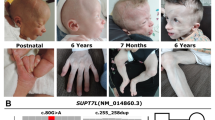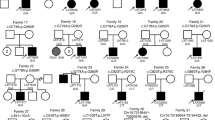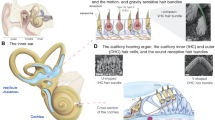Abstract
Defective function of the Sonic Hedgehog (SHH) signaling pathway is the most frequent alteration underlying holoprosencephaly (HPE) or its various clinical microforms. We performed an extensive mutational analysis of the entire human DISP1 gene, required for secretion of all hedgehog ligand(s) and which maps to the HPE 10 locus of human chromosome 1q41, as a HPE candidate gene. Here, we describe two independent families with truncating mutations in human DISP1 that resemble the cardinal craniofacial and neuro-developmental features of a recently described microdeletion syndrome that includes this gene; therefore, we suggest that DISP1 function contributes substantially to both of these signs in humans. While these clinical features are consistent with common HPE microforms, especially those linked to defective signaling by Sonic Hedgehog, we have insufficient evidence so far that functionally abnormal DISP1 alleles will commonly contribute to the more severe features of typical HPE.



Similar content being viewed by others
References
Bendavid C, Haddad BR, Griffin A, Huizing M, Dubourg C, Gicquel I, Cavalli LR, Pasquier L, Long R, Ouspenskaia MV, Odent S, Lacbawan F, David V, Muenke M (2005a) Multicolor FISH and quantitative PCR can detect submicroscopic deletions in holoprosencephaly patients with a normal karyotype. J Med Genet 43:496–500
Bendavid C, Dubourg C, Gicquel I, Pasquier L, Saugler-Veber P, Durou M-R, Jaillard S, Frebourg T, Haddad BR, Henry C, Odent S, David V (2005b) Molecular evaluation of foetuses with holoprosencephaly shows high incidence of microdeletions in the HPE genes. Hum Genet 119:1–8
Burke R, Nellen D, Bellotto M, Hafen E, Senti K-A, Dickson BJ, Basler K (1999) Dispatched, a novel sterol-sensing domain protein dedicated to the release of cholesterol-modified hedgehog from signaling cells. Cell 99:803–815
Caspary T, Garcia-Garcia MJ, Huangfu D, Eggenschwiler JT, Wyler MR, Rakeman AS, Alcorn HL, Anderson KV (2002) Mouse Dispatched homolog1 is required for long-range, but not juxtacrine, Hh signaling. Cur Biol 12:1628–1632
Cohen MM Jr (2006) Holoprosencephaly: clinical, anatomic, and molecular dimension. Birth Defects Res Part A Clin Mol Teratol 76:658–673
Cordero D, Marcucio R, Hu D, Gaffield W, Tapadia M, Helms JA (2004) Temporal perturbations in sonic hedgehog signaling elicit the spectrum of holoprosencephaly phenotypes. J Clin Invest 114:485–494
Kawakami T, Kawcak T\N, Zhang W, Hu Y, Chuang P-T (2002) Mouse dispatched mutants fail to distribute hedgehog proteins and are defective in hedgehog signaling. Development 129:5753–5765
Krauss RS (2007) Holoprosencephaly: new models, new insights. Expert Rev Mol Med 9(26):1–17. doi:1.1017/S1462399407000440
Ma Y, Erkner A, Gong R, Yao S, Taipale J, Basler K, Beachy PA (2002) Hedgehog-mediated patterning of the mammalian embryo requires transporter-like function of Dispatched. Cell 111:63–75
Maity T, Fuse N, Beachy PA (2005) Molecular mechanisms of Sonic hedgehog mutant effects in holoprosencephaly. Proc Natl Acad Sci USA 102:17026–17031
Matsunaga E, Shiota K (1997) Holoprosencephaly in human embryos: epidemiological studies on 150 cases. Teratology 16:261–272
Ming JE, Muenke M (2002) Multiple hits during early embryonic development: digenic disease and holoprosencephaly. Am J Hum Genet 71:1017–1032
Ming JE, Kaupas ME, Roessler E, Brunner HG, Golabi M, Tekin M, Stratton E, Bale SJ, Muenke M (2002) Mutations in PATCHED-1, the receptor for SONIC HEDGEHOG, are associated with holoprosencephaly. Hum Genet 110:297–301
Muenke M, Beachy PA (2000) Holoprosencephaly. In: Scriver CR et al (eds) The metabolic and molecular bases of inherited disease. McGraw-Hill, New York, pp 6203–6230
Nakano Y, Kim HR, Roy S, Schier AF, Ingham PW (2004) Inactivation of dispatched 1 by the chameleon mutation disrupts hedgehog signaling in the zebrafish embryo. Dev Biol 269:381–392
Nanni L, Ming JE, Bocian M, Steinhaus K, Bianchi DW, de Die-Smulders C, Giannotti A, Imaizumi K, Jones KL, Del Campo M, Martin RA, Meinecke P, Pierpont MEM, Robin NH, Young ID, Roessler E, Muenke M (1999) The mutational spectrum of the Sonic Hedgehog gene in holoprosencephaly: SHH mutations cause a significant proportion of autosomal dominant holoprosencephaly. Hum Mol Genet 8:2479–2488
Roessler E, Belloni E, Gaudenz K, Jay P, Berta P, Scherer SW, Tsui L-C, Muenke M (1996) Mutations in the human Sonic Hedgehog gene cause holoprosencephaly. Nat Genet 14 14:357–360
Roessler E, Du YZ, Mullor JL, Casas E, Allen WP, Gillessen-Kaesbach Roeder ER, Ming JE, Ruiz i Altaba A, Muenke M (2003) Loss-of-function mutations in the human GLI2 gene are associated with pituitary anomalies and holoprosencephaly-like features. Proc Natl Acad Sci USA 100:13424–13429
Roessler E, Ermilov AN, Grange DK, Wang A, Grachtchouk M, Dlugosz AA, Muenke M (2005) A previously unidentified amino-terminal domain regulates transcriptional activity of wild-type and disease-associate human GLI2. Hum Mol Genet 14:2181–2188
Shaffer L, Theisen A, Bejjani BA, Ballif BC, Aylesworth AS, Lim C, McDonald M, Ellison JW, Kostiner D, Saitta S, Shaikh T (2007) The discovery of microdeletion syndromes in the post-genomic era: review of the methodology and characterization of a new 1q41q42 microdeletion syndrome. Genet Med 9:607–616
Tian H, Jeong J, Tabin CJ, McMahon AP (2004) Mouse Disp1 is required in sonic hedgehog-expressing cells for paracrine activity of the cholesterol-modified ligand. Development 132:133–142
Tian H, Jeong J, Tabin CJ, McMahon AP (2008) Mouse Disp1 is required in sonic hedgehog-expressing cells for paracrine activity of the cholesterol-modified ligand. Development 135:3471–3472 Corrigendum
Traiffort E, Dubourg C, Faure H, Rognan D, Odent S, Durou M-R, David V, Ruat M (2004) Functional characterization of Sonic Hedgehog mutations associated with holoprosencephaly. J Biol Chem 279:42889–42897
Acknowledgments
We thank the families who participated in these studies and for their ongoing support. This work was supported, in part, by the Division of Intramural Research, the National Human Genome Research Institute, NIH, and by research grants to P.A.B.
Author information
Authors and Affiliations
Corresponding author
Rights and permissions
About this article
Cite this article
Roessler, E., Ma, Y., Ouspenskaia, M.V. et al. Truncating loss-of-function mutations of DISP1 contribute to holoprosencephaly-like microform features in humans. Hum Genet 125, 393–400 (2009). https://doi.org/10.1007/s00439-009-0628-7
Received:
Accepted:
Published:
Issue Date:
DOI: https://doi.org/10.1007/s00439-009-0628-7




